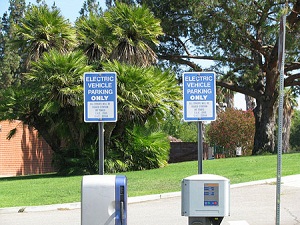Intelligent chargers wait for solar
 While electric vehicles have yet to become popular in the United States, they already enjoy some popularity in Europe, and Germany has set a goal of having one million fully electric cars on the autobahn by 2020. Electric vehicles eliminate harmful emissions, but without renewable energy like solar power contributing to the power grid, they still rely on polluting sources of power such as coal or nuclear fission to keep them moving. In light of this, Germany is also attempting to make sure that thirty percent of its power comes from renewable solar and wind sources by 2020.
While electric vehicles have yet to become popular in the United States, they already enjoy some popularity in Europe, and Germany has set a goal of having one million fully electric cars on the autobahn by 2020. Electric vehicles eliminate harmful emissions, but without renewable energy like solar power contributing to the power grid, they still rely on polluting sources of power such as coal or nuclear fission to keep them moving. In light of this, Germany is also attempting to make sure that thirty percent of its power comes from renewable solar and wind sources by 2020.
Researchers from the Fraunhofer Institute in Germany are working on intelligent charging stations for electric vehicles that will maximize the contribution of solar energy to powering the next generation of electric cars. These chargers operate based on the fact that most electric cars are parked an average of 20 hours a day, meaning that there is some flexibility on when they are actually charged. This means that intelligent chargers wait until a relatively large amount of energy on the power grid is coming from renewable sources; mainly solar cells and wind turbines. When the sun is not shining, the vehicles do not charge, so as to avoid relying on nonrenewable energy sources.
By using information in addition to electricity, intelligent chargers strive to charge vehicles when renewable energy is at its peak, and when demand for power is relatively low. However, consumer choice is also factored in. Vehicle owners would be able to opt to recharge immediately, regardless of prevailing energy demands, or enter the time where they plan on driving next, in order to allow the intelligent charger to charge the car during periods where renewable energy is making its peak contribution to the power grid.
One option being considered in Germany is a variable rate for electricity costs to factor in the growth of renewable energy. When demand is highest, power would cost more, and the rate would lower as solar-derived energy is more available. Intelligent chargers could therefore take advantage of these rates, with a display showing the car owner the energy used and the relative costs of immediate charging versus intelligent charging.



